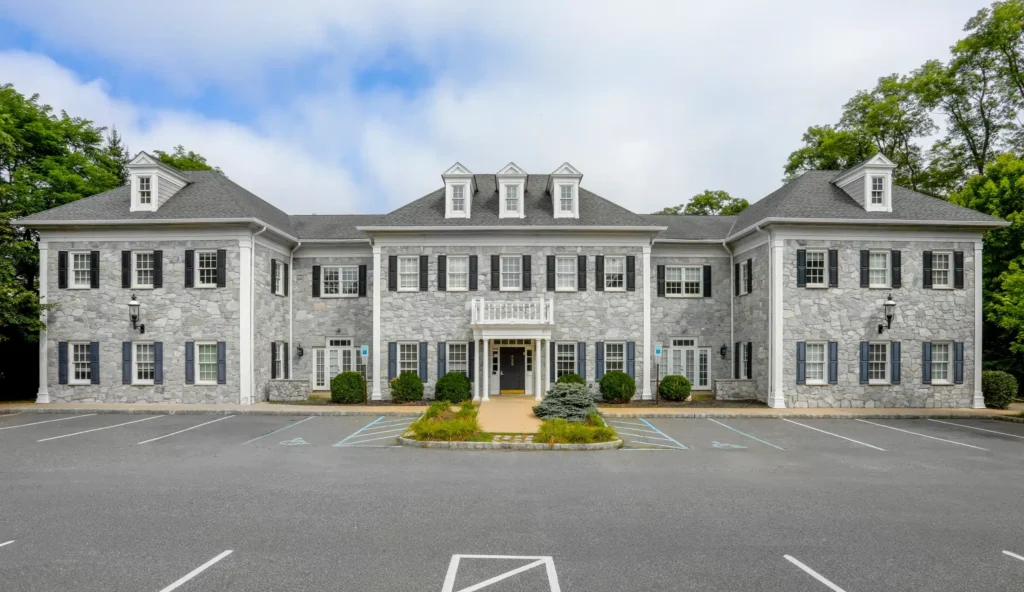Key Takeaways
- Medications for opioid use disorder (MOUD): buprenorphine, methadone, and naltrexone are first‑line care; start early, pair with therapy & recovery supports, and continue as long as helpful.
- Levels of care in New Jersey include medical detox, residential, PHP, IOP, and standard outpatient; match the setting to medical risk, mental health needs, and home safety… not the other way around.
- Safety matters daily: keep naloxone on hand, consider fentanyl test strips, avoid mixing opioids with benzodiazepines or alcohol, and use crisis lines if things escalate.
- Coverage is common: most commercial plans and NJ FamilyCare support MOUD and the full continuum; expect benefit checks, some co‑pays, and clear timelines (detox 3–7 days; residential 2–4 weeks; IOP 6–12 weeks).
- Rolling Hills Recovery Center is a drug and alcohol rehab and addiction treatment center in New Jersey that offers evidence‑based addiction treatment and holistic approaches. The team’s experienced clinicians deliver individualized care, MOUD access, family work, and step‑down planning to help people achieve lasting results.

Overview of Opioid Addiction in New Jersey
What Opioid Use Disorder Means
Opioid use disorder (OUD) is a medical condition marked by loss of control over opioid use, cravings, and continued use despite harm. It can develop with prescription pain medicines like oxycodone or hydrocodone, and with heroin or illicit fentanyl. OUD changes brain circuits that control reward, stress, and self‑control. It is treatable, and recovery can be stable with the right support.
Key points:
- OUD is diagnosed by symptoms such as tolerance, withdrawal, unsuccessful attempts to cut down, and using more or longer than intended.
- Withdrawal does not equal addiction, but it can be one part of OUD.
- Care works best when it combines medications for opioid use disorder (MOUD), counseling, and recovery supports.
How Fentanyl Drives Overdoses in New Jersey
New Jersey’s overdose crisis is driven largely by illicit fentanyl, which is potent and often mixed into heroin or counterfeit pills. According to the state’s public dashboard, fentanyl is present in most overdose deaths statewide. The NJ CARES data show:
- Fentanyl continues to be detected in the majority of fatal overdoses year after year.
- After peaking around 2021, total suspected overdose deaths have shown a gradual decline, though still at very concerning levels.
- Naloxone (Narcan) is used thousands of times per year by law enforcement and EMS in New Jersey, reflecting both risk and life‑saving response capacity.
- Geographic patterns vary; several counties consistently report higher burdens.
These trends make quick access to MOUD, naloxone, and evidence‑based care essential across the state.
MOUD is First‑Line Care
MOUD includes buprenorphine, methadone, and naltrexone. Large studies show MOUD cuts overdose death risk by half or more, reduces return to use, and helps people stay in treatment. National and New Jersey standards recognize MOUD as first‑line. It is not replacing one drug with another; it stabilizes brain chemistry, reduces cravings and withdrawal, and supports recovery.
- Buprenorphine and methadone are agonist therapies. They relieve withdrawal and cravings and lower overdose risk.
- Naltrexone is an antagonist. It blocks opioid effects, but requires full detox first.
Programs in New Jersey should offer MOUD on-site or through coordinated partnerships. Avoid abstinence‑only plans for opioid addiction; they increase relapse and opioid overdose risk.
Safety Basics to Know Right Now
- Carry naloxone. Learn how to use it and keep it visible at home. See the FDA’s OTC resources: FDA naloxone page.
- Assume fentanyl contamination in non‑prescribed pills or powders. Fentanyl test strips can help; they do not make drug use safe, but they reduce risk.
- Do not mix opioids with benzodiazepines, alcohol, or other sedatives unless prescribed together by the same clinician and reviewed for safety. Combining depressants raises overdose risk.
- If you return to opioid use after a period of stopping, your tolerance is lower and overdose risk is higher. Use naloxone strategies and seek MOUD promptly.
- For urgent support, call or text 988 or chat at the 988 Lifeline.
Rolling Hills Recovery Center in New Jersey follows these safety basics, integrates MOUD with counseling, and uses trauma‑informed approaches to support long‑term stability.

Core Rehab Options in New Jersey
Medical Detox with MOUD Induction
Opioid Detox manages acute withdrawal. For opioids, the safest and most effective detox involves starting MOUD early.
What to expect:
- Medical assessment: vital signs, recent use, other substances, mental health history, pregnancy screening when relevant.
- Comfort & safety medicines: clonidine or lofexidine for symptoms; anti‑nausea, anti‑diarrheals; sleep support.
- MOUD induction:
- Buprenorphine: started after mild‑to‑moderate withdrawal begins (to avoid precipitated withdrawal). Often within 12–24 hours of last short‑acting opioid.
- Methadone: can be initiated in an opioid treatment program (OTP) or via hospital protocols; helps when fentanyl exposure is heavy or buprenorphine induction is complicated.
- Transition plan: choose maintenance MOUD and dosing before discharge.
Detox alone is not treatment. Plan the next level of care before discharge.
Inpatient/Residential Stabilization
Residential care provides 24‑hour structure for people who need safety, medical monitoring, or intensive therapy.
Who benefits:
- Recurrent overdose risk, unstable housing, or limited supports.
- Co‑occurring mental health conditions needing stabilization.
- High‑risk environments or complex medical needs.
Core elements:
- On‑site MOUD management, not abstinence‑only.
- Evidence‑based therapies: motivational interviewing, cognitive behavioral therapy (CBT), contingency management (CM).
- Family work and discharge planning from day one.
Partial hospitalization (PHP) and intensive outpatient (IOP)
These levels offer strong structure without a full residential stay.
- PHP: approximately 20+ hours per week, typically weekdays. Good for step‑down from inpatient or higher‑risk outpatient starts.
- IOP: around 9–15 hours per week with evening options. Fits people with work or caregiving duties.
Care includes MOUD management, group and individual therapy, relapse prevention, and routine drug testing to monitor treatment response.
Standard Outpatient and Recovery Management
Outpatient care can be as little as 1–3 hours per week. It focuses on:
- MOUD maintenance and dose adjustments.
- Brief counseling, skills practice, and check‑ins.
- Building a relapse‑prevention plan that includes triggers, coping steps, and clear scripts for what to do if cravings spike.
Recovery management continues after formal treatment: peer support, primary care, mental health therapy, and regular MOUD follow‑ups.
Medication Choices: Buprenorphine, Methadone, Naltrexone
- Buprenorphine (Suboxone and other forms of medication-assisted treatment)
- Pros: office‑based prescribing, high safety margin, flexible dosing, weekly to monthly follow‑ups.
- Cons: requires mild withdrawal for induction; fentanyl can complicate timing. Micro‑induction protocols can help.
- Forms: daily sublingual films/tablets; long‑acting injections exist.
- Methadone
- Pros: strong craving control; gold standard for those with heavy fentanyl exposure or long‑term heroin use.
- Cons: daily clinic visits at first; QTc monitoring when needed; interactions with sedatives.
- Provided through certified OTPs.
- Naltrexone (Vivitrol is an extended‑release injection)
- Pros: monthly injection; no opioid agonist effects.
- Cons: must be fully detoxed (7–10 days opioid‑free typically, longer with methadone); challenging after heavy fentanyl exposure; best for highly motivated patients or those not tolerating agonists.
All three are effective when matched to the person’s needs. Shared decision‑making should guide selection.
Evidence‑Based Therapies That Help
- Cognitive behavioral therapy (CBT): targets thought patterns and behaviors that feed use; builds coping and problem‑solving skills.
- Contingency management (CM): uses small, structured rewards for attending sessions and achieving goals like negative drug screens; improves retention.
- Motivational interviewing (MI): strengthens the person’s own reasons for change and autonomy.
- Trauma‑informed care: recognizes the role of trauma and avoids re‑traumatization.
- Skills groups: sleep, stress, pain management, and mindfulness strategies. Physical activity can support mood and recovery. See more on movement and recovery in exercise in addiction recovery.
Family Involvement and Co‑Occurring Mental Health Care
Family can be a protective factor. Effective programs offer:
- Family education on OUD, MOUD, and overdose response.
- Structured family sessions to improve communication and boundaries.
- Parenting support where needed.
Co‑occurring mental health conditions are common (depression, anxiety, PTSD, ADHD). Treatment should include:
- Psychiatric evaluation and medication management coordinated with MOUD.
- Integrated therapy for both conditions.
- Special tracks for neurodiversity and attention challenges; learn more about links between attention symptoms and substance risk here: ADHD and addiction.
State Standards and Oversight
In New Jersey, programs should meet licensing requirements set by the Division of Mental Health and Addiction Services (DMHAS). You can review standards and public resources at NJ DMHAS. Look for transparent policies, patient rights information, and clear escalation pathways for clinical issues.
How to Choose a Program in New Jersey
A Practical Step‑by‑Step Checklist
- Confirm state license.
- Ask for the program’s NJ DMHAS license number and level(s) of care.
- Check accreditation.
- The Joint Commission or CARF signal adherence to quality standards.
- Verify MOUD is offered on-site.
- Ask if buprenorphine and naltrexone are prescribed in‑house, and how methadone is coordinated with an OTP.
- Review individualized care plans.
- How are goals set? Are co‑occurring disorders addressed?
- Ask about evidence‑based therapies.
- CBT, MI, CM, trauma‑informed care. Request examples of how these are delivered each week.
- Confirm naloxone and fentanyl risk reduction.
- Do they train families on naloxone? Provide overdose education and links to test strips?
- Assess access & fit.
- Evening IOP, transportation support, telehealth options, language services.
- Special populations.
- Perinatal, veteran, LGBTQIA‑affirming care. For inclusive services, see LGBTQIA support in New Jersey.
- Outcomes transparency.
- What metrics do they track? Retention rates, MOUD continuity, linkage to ongoing care.
- Insurance verification.
- Ask for a same‑day benefits check and a written estimate of out‑of‑pocket costs.
Programs like Rolling Hills Recovery Center align with these steps by offering MOUD, trauma‑informed therapy, and family involvement within a coordinated care plan.
Accreditation, MOUD, and Clinical Depth
- Accreditation: The Joint Commission or CARF shows external review of safety & quality.
- Clinical staffing: board‑certified addiction medicine or psychiatry, licensed therapists, and nurses with detox/withdrawal skills.
- MOUD readiness:
- Buprenorphine induction expertise including micro‑induction for fentanyl exposure.
- Naltrexone induction protocols (with bridging comfort meds).
- Methadone coordination with a nearby OTP if not on site.
- Discharge planning starts at intake: People leave with a written plan, appointments scheduled, and naloxone.
Access and Flexibility Matter
- Evening and weekend IOP slots help keep work or school on track.
- Telehealth follow‑ups can support MOUD maintenance.
- Transportation help or proximity to public transit is key.
- Language access: bilingual staff or interpreters.
- Perinatal care: MOUD in pregnancy is evidence‑based and safer than withdrawal; link to prenatal care.
- Veterans: coordination with VA benefits and trauma‑informed tracks.
Outcomes and Insurance Verification
Ask for:
- Treatment retention rates at 30/90 days.
- MOUD continuation rates after discharge.
- Linkage success to outpatient providers within 7 days.
Insurance verification template (use this when calling your insurer):
- “I’m calling to verify behavioral health benefits for opioid use disorder treatment in New Jersey. Which in‑network providers offer:
- Medical detox with MOUD?
- Residential treatment?
- PHP/IOP?
- Outpatient with MOUD maintenance?
- Is buprenorphine, methadone via OTP, and naltrexone covered? What prior authorizations are needed?
- What are my copays, coinsurance, and deductibles?
- Do I need a referral or pre‑certification?
- Are urine drug screens, labs, and counseling included?
- What transportation or telehealth benefits are available?”
Request a reference number for the call.

Costs, Coverage, and Access
Insurance Benefits Checks and Parity Protections
- Most commercial plans cover OUD treatment due to federal and New Jersey parity laws. Behavioral health benefits must be comparable to medical/surgical benefits.
- Ask the provider to run a same‑day benefits check. They should explain any prior authorization steps and likely out‑of‑pocket costs.
- Keep all approvals in writing. If a service is denied, ask about internal appeals and peer‑to‑peer review options.
NJ FamilyCare (Medicaid) and What it Covers
Many New Jersey residents qualify for NJ FamilyCare. Visit NJ FamilyCare to check eligibility and enroll.
Common coverages with NJ FamilyCare:
- MOUD, including buprenorphine and naltrexone, in outpatient or integrated settings.
- Methadone through certified opioid treatment programs (OTPs).
- Levels of care: detox, residential, PHP/IOP, and outpatient, when medically necessary.
- Naloxone coverage per plan policies; OTC naloxone is also widely available without a prescription. See the FDA naloxone page.
If you are uninsured, ask programs about state block‑grant slots, sliding scale options, or help accessing NJ FamilyCare.
Typical Out‑of‑Pocket Ranges
Costs vary by location, level of care, and insurance. Ballpark ranges in New Jersey:
- Detox: with insurance, often copays/deductibles only; self‑pay can be several thousand dollars for a brief stay.
- Residential: most commercial plans cover part of costs; self‑pay can be high, but financial assistance may be available.
- PHP/IOP: commonly covered; self‑pay often hundreds per week depending on hours.
- Outpatient MOUD: office visits and medications are often covered; generic buprenorphine is typically affordable, and many pharmacies discount prices.
Always request a written estimate after benefits verification.
Financial Assistance and Practical Options
- In‑network care lowers out‑of‑pocket spend.
- Apply for NJ FamilyCare if eligible.
- Ask about payment plans, sliding scales, or scholarships.
- Some programs provide transportation passes or telehealth visits when distance is a barrier.

Getting Started and Staying Safe
Quick Screening and Scheduling an Assessment
You can move from decision to treatment fast, often same day.
Simple self‑check (screening prompts):
- Are opioids taken in larger amounts or longer than planned?
- Have there been unsuccessful attempts to cut down?
- Strong cravings or spending a lot of time getting/using/recovering?
- Use causing problems at home, work, or health?
- Withdrawal symptoms when cutting down?
If “yes” to several, schedule an assessment:
- Call the program and ask for the next available clinical assessment for OUD with MOUD options.
- Request guidance on whether an in‑person or telehealth intake is available and what documents to bring.
A program like Rolling Hills Recovery Center can coordinate a rapid assessment, start MOUD when appropriate, and map your level of care based on safety and home supports.
What to Bring to Admission or Intake
- Photo ID, insurance card, and a list of current medications.
- Emergency contacts and pharmacy information.
- Medical records if available (recent EKG, labs, prior discharge summaries), but don’t delay care if you don’t have them.
- Comfortable clothing, a list of allergies, and any assistive devices.
- Names and doses of prescribed medications including benzodiazepines or sleep aids.
Tip: Keep a simple folder with your insurance approval numbers, scripts, and appointment times.
Realistic Timelines for Care
- Detox: 3–7 days for most opioids; fentanyl exposure can prolong symptoms; MOUD stabilizes faster.
- Residential: 2–4 weeks is common for stabilization, skills practice, and planning.
- IOP: 6–12 weeks with regular progress checks.
- Outpatient MOUD: ongoing; monthly visits are typical once stable.
Timeframes vary. The key is continuity, no gaps between levels.
Your MOUD and Relapse‑Prevention Plan
Before discharge or step‑down, ensure these are in writing:
- MOUD details: medication, dose, pharmacy, next appointment, and how to handle missed doses.
- Symptom plan:
- If cravings spike: use coping steps (urge surfing, call support), take MOUD as prescribed, and contact your care team.
- If you use: avoid shame spirals; call the clinic; adjust MOUD dose or level of care promptly.
- Trigger map: people, places, pain flares, sleep problems. Match each trigger with one practical action.
- Recovery supports: peer groups, family check‑ins, exercise routine, and therapy sessions. If adding movement helps, see exercise in addiction recovery.
- Refill safety: set calendar reminders 7 days before running out.
Simple relapse‑prevention template:
- My early warning signs are: (list 3–5)
- What I will do first: (call X, take a walk, use coping card, text sponsor/peer)
- Medications: (name, dose, refill date)
- Emergency steps: (carry naloxone, call clinic, consider urgent appointment)
Overdose Risk Reduction: Your Safety Kit
Build an overdose safety kit and keep one at home and one with you.
Essentials:
- Naloxone nasal spray (2–4 doses). Teach family & friends how to use it.
- Fentanyl test strips when available; they reduce but do not eliminate risk.
- A laminated action card:
- If someone is unresponsive: 911, naloxone, rescue breathing.
- If you use again: use with someone present if possible; go slow; avoid mixing with alcohol or benzos; keep naloxone visible.
- Medication list and allergies.
- 988 Lifeline information for crisis support.
Brief naloxone steps:
- Check responsiveness, call 911.
- Administer naloxone spray in one nostril.
- Rescue breathing (1 breath every 5–6 seconds) if trained.
- If no response in 2–3 minutes, give a second dose.
- Stay until help arrives; withdrawal may appear but breathing is the priority.
Avoid Dangerous Combinations and Situations
- Do not mix opioids with benzodiazepines, alcohol, or gabapentinoids unless managed by one prescriber with clear monitoring.
- After periods of abstinence, use of the same amount as before can be fatal, and tolerance resets.
- Never drive or operate machinery when sedated.
- Store medications locked and away from children; dispose of unused opioids at take‑back sites.
Crisis and Ongoing Support
- Emergencies: dial 911.
- Mental health or substance use crisis: call or text 988 or chat at the 988 Lifeline.
- Pharmacy help: ask your pharmacist to demonstrate naloxone steps and to review interactions with other meds.
- Primary care: keep them in the loop; coordinate pain management, sleep, and mental health care alongside MOUD.
How Rolling Hills Recovery Center Can Fit Into Your Plan
Rolling Hills Recovery Center is a New Jersey program that provides evidence‑based treatment and holistic supports. Care typically includes:
- On‑site MOUD with buprenorphine and naltrexone, and coordination for methadone when needed.
- Medical detox, residential stabilization, PHP/IOP, and outpatient follow‑ups.
- Integrated mental health care, family involvement, and trauma‑informed therapy.
- Skills work that includes sleep, stress reduction, and optional wellness strategies alongside clinical care.
The team works to create a practical plan that prioritizes safety, continuity, and long‑term stability. For those seeking inclusive care, specialized tracks can support unique needs, including LGBTQIA‑affirming services and neurodiversity‑informed approaches.
Conclusion
Opioid rehab in New Jersey focuses on safe detox, MOUD & therapy. Top points: meds boost recovery, care levels match needs, naloxone saves lives… If you’re ready, Rolling Hills Recovery Center is a drug and alcohol rehab and addiction treatment center in New Jersey that offers evidence-based addiction treatment and holistic approaches. Our team of experienced professionals is dedicated to helping individuals overcome substance abuse and achieve lasting results. Call or book an assessment today.
Frequently Asked Questions (FAQs)
What does rehab for opioid addiction options in New Jersey usually include?
Rehab for opioid addiction options in New Jersey typically cover medical detox, medications for opioid use disorder (MOUD), therapy, and aftercare. Detox manages withdrawal safely. MOUD—buprenorphine, methadone, or naltrexone—reduces cravings & prevents relapse. Therapy often includes cognitive behavioral therapy, contingency management, family sessions, and peer support. Levels of care range from inpatient/residential to partial hospitalization (PHP), intensive outpatient (IOP), and standard outpatient. Most effective plans also include naloxone education, overdose risk reduction, and coordination with primary care.
How does MOUD fit into rehab for opioid addiction options in New Jersey?
Within rehab for opioid addiction options in New Jersey, MOUD is first‑line treatment. Buprenorphine and methadone activate opioid receptors in a controlled way to ease withdrawal and cut overdose risk. Naltrexone blocks receptors to help prevent return to use after detox. MOUD is paired with therapy and recovery planning; it is not replacing treatment, it’s part of it. Induction can start in detox or outpatient. Ongoing follow-up includes dose adjustments, urine toxicology when appropriate, and counseling focused on coping skills.
How to choose between inpatient, PHP, IOP, or outpatient among rehab for opioid addiction options in New Jersey?
Match the level of care to clinical needs. Consider overdose risk, fentanyl exposure, prior attempts, co‑occurring mental health conditions, home stability, and transportation. Inpatient/residential is appropriate for high withdrawal risk, medical complications, or unsafe housing. PHP/IOP fits those who need daily or near‑daily structure but can sleep at home. Standard outpatient works for stable patients on MOUD with strong supports. Whichever option is chosen, look for licensed programs, on‑site MOUD access, trauma‑informed care, family involvement, and a clear discharge plan. Evening IOP and telehealth can help with work and childcare.
What will insurance typically cover for rehab for opioid addiction options in New Jersey?
Many plans, including New Jersey Medicaid (NJ FamilyCare) and commercial insurers, cover MOUD, detox, inpatient, PHP, IOP, and outpatient—subject to medical necessity and plan rules. Parity laws require mental health and substance use benefits comparable to medical/surgical benefits. Expect prior authorization in some cases, co‑pays or deductibles, and coverage for naloxone. Keep records: prescriptions, visit summaries, and appeal letters if needed. If uninsured, ask about state funding, payment plans, or sliding scale. Don’t delay treatment while sorting coverage—intake teams can verify benefits quickly.
Why consider Rolling Hills Recovery Center when comparing rehab for opioid addiction options in New Jersey?
Rolling Hills Recovery Center is a drug and alcohol rehab and addiction treatment center in New Jersey that offers evidence-based addiction treatment and holistic approaches. Our team of experienced professionals is dedicated to helping individuals overcome substance abuse and achieve lasting results. Care plans may include MOUD & therapy, trauma‑informed approaches, family work, and step‑down paths from higher to lower levels of care. The focus remains on safety, measurable progress, and sustainable recovery with real‑world support.
Author
-
Our editorial team includes licensed clinicians and board-certified addiction specialists. Every article is written and reviewed to be clear, accurate, and rooted in real treatment experience.
View all posts -
Dr. Williams has held senior leadership positions in the behavioral health field for over 30 years. He has worked with diverse populations in various private and public sectors.
View all posts












